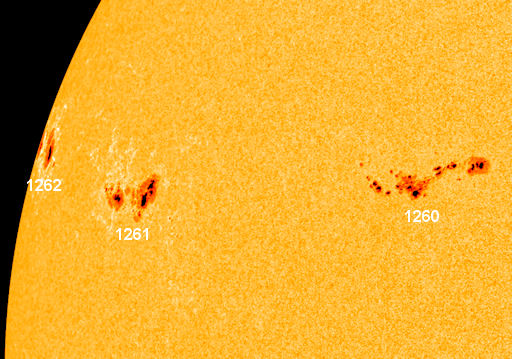NOAA forecasters estimate a 40% chance of M-class solar flares today. The source would be one of three big sunspots emerging along the sun's northeastern limb. Click on the image to view a 3-day movie from NASA's Solar Dynamics Observatory:
Among the three, the leading sunspot AR1260 is most active. It has produced more than a dozen C-class flares in the past 24 hours, more than doubling the total for the entire month of July so far. New sunspot AR1262, however, could eventually cause more trouble. Magnetograms of the active region reveal a delta-class magnetic field that harbors energy for powerful X-class eruptions.
A solar flare is an explosion on the Sun that happens when energy stored in twisted magnetic fields (usually above sunspots) is suddenly released. Flares produce a burst of radiation across the electromagnetic spectrum, from radio waves to x-rays and gamma-rays.
Scientists classify solar flares according to their x-ray brightness in the wavelength range 1 to 8 Angstroms. There are 3 categories: X-class flares are big; they are major events that can trigger planet-wide radio blackouts and long-lasting radiation storms. M-class flares are medium-sized; they can cause brief radio blackouts that affect Earth's polar regions. Minor radiation storms sometimes follow an M-class flare. Compared to X- and M-class events, C-class flares are small with few noticeable consequences here on Earth.

No comments:
Post a Comment